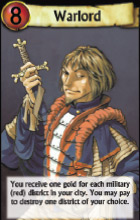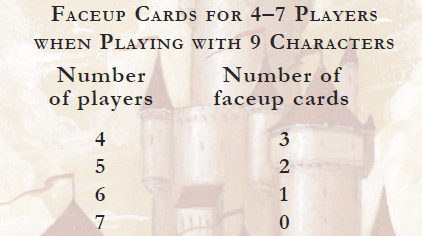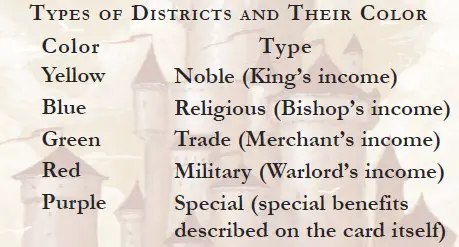Fourteen of the purple district cards are bonus cards marked by a white star. Before you play your first game, remove these cards.

Character Cards
These cards represent the characters that players seek to influence during every game round. There are eight basic characters in Citadels, but in this edition you will also find 10 additional bonus character cards marked by a white star. These bonus characters are not used in the basic game. Before you play your first game, remove these cards.
In addition to a special ability, each character card has a rank number between one and nine. This number is printed on the upper left-hand side of the card.
Reference Cards
Each player takes one of these cards at the beginning of the game. They are useful for gameplay, especially during your first few games.
Bonus Cards
Citadels includes 10 bonus character cards and 14 bonus purple district cards, all marked with a white star. You can add these bonus cards to your Citadels game for more fun and variety.
Bonus Characters
The bonus character cards are used as follows: Before the game begins, players may agree to remove one or two of the original eight character cards and replace them with the bonus characters of the same rank numbers. For example, you may agree to remove the Merchant (#6) and replace him with the Alchemist (#6).
If you decide to use one of the rank 9 characters in a four- to seven-player game, you must place a number of random cards faceup at the beginning of each round, as detailed in the table below.

When using a rank 9 character card, you can play Citadels with eight players. When playing with eight players, simply use the rule for the seven-player game in which the last player may choose between the remaining character and the facedown character in the middle of the table.
Bonus Districts
Before the game begins, players may agree to add 2-3 additional purple district cards to the District Deck from the 14 available bonus district cards. If players wish to use more than 2-3 of the bonus district cards, they should remove one existing purple district card for each additional bonus district card used.
District Cards

These cards represent the various districts that you can add to your city. Each district card has a cost, represented by a number of gold coins along the card's left edge. In order to put a district card into play, you must pay its cost in gold.
Each district card also exhibits a colored circle on its bottom left-hand corner, which tells you what type of district it is:

There are certain district cards with effects that need to be explained in further detail:
-
Bell Tower
The Bell Tower's ability affects endgame scoring in the following ways: Bonuses are awarded for seven districts instead of eight. If one or more players have seven districts when the Bell Tower is built, they all receive the four bonus points for simultaneously meeting the endgame condition. If the Bell Tower is built as someone's seventh district, he and anyone else with seven districts get four bonus points for simultaneously meeting the endgame condition. Any players who subsequently reach seven districts before the round (and the game) ends receive two bonus points.
-
Observatory & Library
The Observatory's ability allows a player to draw three cards and keep only one; the Library's ability allows a player to keep both cards he draws. When these two districts are owned by the same player, they allow him to draw three cards and keep two of them.
-
Quarry
The Quarry's ability is triggered when someone builds, so if the Quarry is destroyed, its owner does not lose any duplicate districts he has already built. The owner of the Quarry may build multiple duplicate districts, but there may not be more than two identical districts in his city.
-
Graveyard
The Graveyard's ability may not be used to save itself; since it is destroyed, it is no longer in play and its ability is void.
Continue Reading

